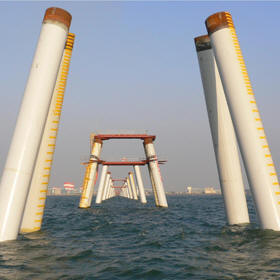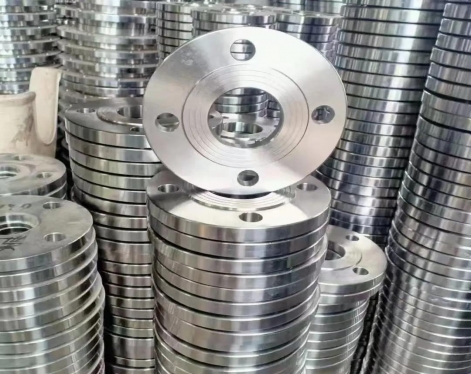1.What is lsaw steel pipe pile?
LSAW (Longitudinal Submerged Arc Welded) steel pipe pile is a type of structural pipe commonly used in construction and infrastructure projects, particularly in foundation and piling applications. It is manufactured through a welding process where a steel plate or coil is formed into a cylindrical shape and then longitudinally welded using submerged arc welding techniques.(1)What are piling pipes?
piling pipes are permanent materials for load-bearing steel pipes. They are called the main material in engineering. The quality, anti-corrosion and welding requirements for the steel pipe materials are very high. The length of steel pipe piles is generally between 50-70 meters. No cement is poured inside, and the steel pipe directly bears the force, requiring a long service life. The length of a single steel pipe pile depends on the conditions of the piling machine and the geological conditions of the construction site.(2)What is lsaw pipe?
LSAW pipe is a type of steel tube, which is made by straight seam submerged arc welding process. Longitudinal submerged arc welded pipes usually consist of black and galvanized steel pipes with two different surface treatments. Its wall thickness, diameter and length can be customized as required. Using a single medium-thick plate (stainless steel medium-thick plate) as the processing raw material, the stainless steel plate is first pressed (rolled) into a tube blank in a mold or forming machine, and is produced by double-sided submerged arc welding and diameter expansion.
Its finished products have a wide range of specifications, and the welds have good toughness, plasticity, uniformity and density. The advantages are large pipe diameter, thick pipe wall, high pressure resistance, low temperature resistance and strong corrosion resistance. When constructing high-strength, high-toughness, high-quality long-distance oil and gas pipelines, the steel pipes that need to be used are basically large-diameter, thick-walled straight seam submerged arc welded pipes. According to API standards, in large oil and gas transmission pipelines, when passing through Class 1 and Class 2 areas such as alpine zones, seabed, and densely populated urban areas, the designated applicable pipe type is straight seam submerged arc welded pipes.
2.Advantages and disadvantages of lsaw pipe piling
Advantages: high strength, large bending resistance, can withstand large horizontal forces; good elasticity, can absorb large deformation energy. It can reduce the impact force of ships on dock buildings; it is convenient to manufacture and construct, and can speed up the construction progress of dock buildings.Disadvantages: The amount of steel is large, about 3 to 4 times that of reinforced concrete piles; the cost is high, about 2 to 3 times that of reinforced concrete piles; it is easy to rust and has poor durability.3.Construction of lsaw steel pipe piling
(1) Structure, type and specifications①The pipes of steel pipe piles are generally made of ordinary carbon steel. There are two types of spiral seam steel pipes and straight seam steel pipes. Due to its high stiffness, spiral welded steel pipes are used more often in engineering.
② As accessories for steel pipe piles, there are mainly pile caps welded to the top of the pile to withstand higher loads, flat steel strips welded to the top of the steel pile and protective rings to protect the bottom of the pile, and copper welding for pile sections. folder.
(2) Select piling machinery. There are mast type, column foot type, tower type, gantry type, etc. The three-point support mast type diesel pile driver is commonly used.
(3) Piling sequence. There are two methods: first dig and then pile, then pile and then dig. In soft soil areas, the construction method of piling first and then digging is generally used.
(4) Transportation and hoisting of piles. Steel pipe piles can be transported to the site with a flatbed trailer, unloaded on the side of the pile machine with a crane, and stacked according to the pile driving sequence and pile support requirements, paying attention to the direction. When the site is wide, a single-layer layout should be adopted. Suspended steel pipe piles are mostly tied and lifted. When the pile is lifted to the pile position, the pile is inserted and the steel pipe pile is aligned with the sample pile position previously marked with lime, so that the pile position is straight and the pile body is straight.
(5) Piling. To prevent damage to the pile head during hammering, a special pile cap should be placed on top of the pile head before piling. Shock-absorbing wood pads should be placed on parts that receive direct hammer blows.
(6) Connect piles. The pipe diameter should be welded with equal strength groove welds; if the pipe diameter is changed, flanges and bolts can be used for connection, and the same strength requirements should be met. Steel pipe piles are usually welded.
(7) Send piles. When there is a certain gap between the top elevation of the pile and the ground and a pile connection is no longer required, piles can be used to drive the pile to the design elevation. The pile barrel should meet the following requirements: the driving resistance should not be too large; the striking energy can be effectively transferred to the pile driver, and it can be easily pulled out and can be used continuously.
(8) Penetration control. The criteria for stopping driving are based on the driving depth, combined with comprehensive judgments such as the amount of driving during pile driving, the number of hammer blows in the last 1 m and the total number of hammer blows per pile.
(9) Steel pipe pile cutting.
(10) Weld the pile cover and connect the pile end to the cap.









